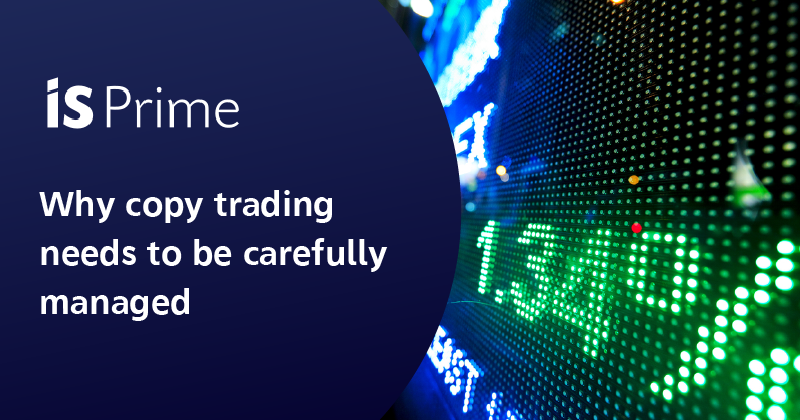Why copy trading needs to be carefully managed

Following IS Prime’s recent announcement about our partnership with Pelican Trading to integrate their social copy-trading technology into our trading platforms, it’s worth exploring some of the potential issues that copy trading can raise for both retail brokers and Liquidity Providers (LPs), and how IS Prime helps address those issues.
A growing trend
The explosive growth of social trading over the last few years (in particular, copy trading or mirror trading) has been well documented in the media and this trend looks set to continue. There has also been a huge rise in the use of ‘Expert Advisors’ (EAs) in MT4 and MT5, which allow trading signals and strategies to be packaged for other traders to follow. These EAs have become increasingly popular and are heavily marketed to retail traders as a simple way to trade ‘proven’ strategies.
At first glance, this trend may seem to benefit retail brokers and LPs, given the increasing numbers of traders and the accompanying growth in volumes.
But it is a double-edged sword. Over time, copy trading and the use of EAs can have a negative impact on liquidity and, unless managed correctly, it actually widens spreads.
Diminishing returns?
To understand why this is the case, consider how copy trading generally works. Whether a trader is mirroring the trades of another user, or whether a large number of users are employing the same EA, the effect can be the same.
Looking at this from the perspective of EAs – the majority of such strategies are based around signals that are defined by technical levels, which means that they generally trigger at the same time. For example, EUR/USD hits 1.1000 and everyone buys. We see this kind of thing all of the time at IS Prime.
Retail brokers obviously want as much of this flow as possible, because if the strategies continue working, then the number of copy traders will continue to increase and the volumes will continue to grow.
However, if the retail broker is unable to manage those executions effectively, then the copy trades become a self-fulfilling prophecy in that, once everyone starts buying, the market starts moving up. Although the early traders will benefit from the subsequent price move, for those late to the party, the market will have already moved by the time their order is filled, which is obviously the worst possible outcome for the copy trader.
This results in diminishing returns for the copy traders and therefore less business for the retail broker.
Impact on Liquidity Providers
Another factor to consider is how poorly managed copy trading flow impacts LPs. If you have 100 or 1,000 users all trading at the same time based upon the same signal, and you’re trading inefficiently in the market by sweeping the entire book, then you're pushing the price against your LPs. And if you continue to do this, then eventually your LPs are naturally going to widen your pricing.
The ability to scale is therefore a key aspect of managing copy trading flow. Brokers who are able to execute in a way that doesn’t hurt their LPs will continue to receive tight prices, whereas those aren’t, won’t.
These issues can be particularly problematic in the current extremely volatile environment as, with the huge moves we are seeing across the FX, Futures and Equities markets, the potential impact can be more pronounced and cause even greater damage to LPs.
So how does IS Prime address these issues?
Addressing the challenges
The core component of our copy trading solution is our internally developed batch hedger, which enables brokers to provide the same fill price to all copy traders without having to route each trade individually. Our technology identifies the copy trades, batches the full order out to the market and splits the fills back to the original trade sizes, all at the same average price.
This benefits brokers because their clients who are copying a given trading strategy are not all receiving fills at different prices. This means they can handle copy trading flow at scale and give everyone a better fill, because the last trader coming into that strategy isn't immediately at a disadvantage.
Also, it benefits LPs because they are being hit once in a larger size, rather than multiple times at smaller sizes in a moving market, which allows them to offset their risk more efficiently. The result is that they don’t need to widen their spreads to compensate.
In conclusion, this is a win-win-win for all parties. Copy traders get filled at fair prices, retail brokers continue to benefit from competitive spreads and are able to continue to service copy trading flow at scale, and LPs are better able to offset their risk.
To learn more about IS Prime and our products and services, please feel free to reach out:






